 |
 |
 |
 |
| Volume
3 - Issue 11 NOVEMBER 2005 |
|
PRASHANTI DIARY The months of September and October are festive months in the Parthi Calendar. While the Krishnajanmastami and the Ganesh Chaturthi festivals were covered in the last issue, in this issue we bring a report on the Dasara festival and the 'Veda Purusha Saptaha Jnana Yagna' that is conducted every year during this festival. While the yagnam (or the ritual fire sacrifice) is performed in the morning during the entire week, the evening too provides a rich fare for the sincere seeker - the Prashanti Vidwan Maha Sabha. The Prashanti Vidwan Mahasabha was started in 1972 wherein learned pundits were invited to give discourses on various aspects of spirituality to the congregation. In recent years however, the speakers are drawn mostly from the staff and students of the Institute and elder devotees. Along with Dasara festival also occurs the Grama Seva activities by the students of the SSSIHL, where the students actually go and distribute food packets and clothes to every individual household in villages in the 3 mandals (sub-districts) of Puttaparthi, Bukkapatnam, and Kottacheruvu. In this report we cover all these functions. While these functions overlap and are intimately intertwined as they happen almost simultaneously, for the sake of clarity and comprehension we report them separately. In a departure from our normal chronological reporting of events, we bring alive for you first (through photographs and a descriptive accompanying text) the major cultural programs performed by the students during this past month, before we go on to report on the Dassera and the Grama Seva activities. SEPTEMBER 25, 2005 : A BHANGRA DANCE BY THE PRASHANTI NILAYAM CAMPUS In the evening of Sept. 25th, the students of the Prashanti Nilayam campus provided a visual treat to the audience when they performed a vibrant and pulsating dance form from the fertile valleys of the Punjab known as the bhangra.
The dance focussed on the life of a farmer, his routine, worries and the blessed moments of his life. The dance told the story of how a typical Punjabi farmer thanks God on waking for the fitful sleep and also seeks His grace for all activities to be performed during the day. He then goes to till the fields and begins work only after expressing a prayer to the tilling instruments. The dance leads the audience through the various stages of cultivation - tilling, sowing, weeding and so on. After months of work, when the crops are almost grown, the monsoon plays hide and seek and the poor farmer is in danger of losing his entire crop. When the farmers are bemoaning the forthcoming loss, there enters a sage who tells them to pray to God for showers. All of them then sing together and along expected lines the rains pour profusely resulting in a bumper harvest. The ecstatic farmers harvest the fields and remove the wheat from the chaff in a joyous spirit of celebration and thanksgiving. The wheat is then packed in large sacks and trundled off to the market; with the farmers dancing and singing all the way there and back and continually expressing their love to God and thanking Him for providing everything for them. The dance was choreographed by 2 devotees from Chandigarh - Mr. Desraj Singh and Mr. Bhupinder Singh; they not only taught the students the dance steps but Mr Desraj also played the dhol (the native Punjabi percussion instrument) and sang the Punjabi song that provided the backdrop for this unusual and unique cultural event.
SEPTEMBER 28, 2005 : 'SATHYAM VADA, DHARMAM CHARA' - A DRAMA BY THE HIGH SCHOOL STUDENTS This standout drama entitled - 'Sathyam Vada, Dharmam Chara' meaning "Speak the Truth and Perform Righteous Actions" was conducted by the high school students in the classical language of Sanskrit to the astonishment and wonderment of all present in Sai Kulwant Hall. Incidentally 'Sathyam Vada Dharmam Chara' is also the Institute motto. The play (which started with an introductory dance) was conducted in two parts.
They decide to rob the king's treasury. Mahendra finds 3 huge diamonds in a chest in the king's treasury and steals one and gives one to his "friend" - the king in disguise. He leaves the 3rd one behind in spite of the king's entreaties to steal it also. The next morning the king, now out of his disguise, asks his minister to check the treasury. The minister reports that all the 3 diamonds are missing. The king summons Mahendra to his court who confesses (truthfully in accordance with his vow) that he stole only 2 diamonds from the treasury. The king then finds the treasurer had kept the 3rd diamond and hence sends him to jail and installs the truthful Mahendra in his place. The second part of the play 'Dharmam Chara' tells the story of a sage Mahatapa, who has accumulated great powers as a result of severe austerities. Once angered at a bird he turns it to ashes with a glance since it left its droppings on him. This sage then goes to the house of a chaste woman to ask for alms. She angers him by asking him to wait till she finishes serving her husband. When the sage shows his anger, the woman mocks him by asking if she is a mere bird that he could reduce to ashes. This astonishes the sage and the woman explains that she got all her knowledge merely by the dharma of serving her husband and not through sadhana or spiritual practice. She asks him to go to Mithilapura and meet a butcher by name Dharmavyadha. When the sage reaches the butcher's shop, he is asked by the butcher whether the chaste woman has sent him to Mithilapura to meet him. Again being shocked at his knowledge the sage wonders if the butcher has done tapas (severe austerities) or sadhana to gain such powers. The butcher explains that he is simply a devotee of his parents and offers all he does to God. The sage tries to argue with the butcher about his vocation and is in turn questioned whether what he did to the bird was non-violence. The sage gets transformed and the boys bring the drama to a close by singing a touching finale song for Swami. OCT 12: A DRAMA BY THE STUDENTS OF THE BRINDAVAN CAMPUS ON THE LIFE OF THE POET-SAINT SURDAS On the evening of October 12, after the completion of the Poorna Ahuti or the concluding session of the week-long yagna and Surdas is very popular as an exemplar of the tradition of Bhakthi Yoga as he willingly chose to live a life of darkness for he felt there was no sight worth seeing other than the magnificent form of Lord Krishna. In the opening scene the sage is wandering through a village singing bhajans when his gaze is attracted by a lissom lass in front of a hut. Surdas feels miserable that worldly pleasures still bind him and so he plucks his eyes out with thorns from a nearby bush, as these eyes had distracted him away from God. He is then shown facing the ridicule of the villagers for being a hypocrite and a show-off. Surdas' life takes a turn for the better when he gets a guiding light in the form of Guru Vallabhacharya, who shows Surdas the right path of devotion to Krishna. Surdas now intensifies his quest for the vision of Lord Krishna, and this intensity is reflected in his pining songs. The boys sing "Maili chadar…." very feelingly to the intense delight of the crowd.
But Surdas is rescued by a cowherd boy and Surdas soon realizes that it is the divine shepherd Himself - his beloved Lord Krishna. So he begs Krishna for His Darshan which Krishna grants him by restoring his sight. After the divine darshan, in a moving scene, Surdas asks Krishna to take his eyes back as he felt that there was nothing else worth seeing. The men who tried to kill him were also witness to this scene, immediately repent and sincerely seek Surdas' forgiveness. The closing scene shows Surdas who after many long years of contemplation and service to Lord Krishna has grown old physically but his passion for the Lord is still as intense as ever. He now begins to see God in everyone and addresses them as Krishna. He feels a sudden urge to leave his body and merge with the Lord. The Lord then appears and in a touching scene He tries to convince Surdas to remain for some more time in the world. The sage pleads piteously to be allowed to reach His Lotus Feet and the Lord finally relents….. The boys brought the entire story to life with their attractive costumes, soul lifting melodious songs and realistic portrayal. The scene in which Surdas plucks his eyes out was especially touching. Swami profusely blessed all the actors and also spoke lovingly a few words with the boy who portrayed the role of Surdas. GRAMA SEVA - SERVING IN THE VILLAGES OCT 4 TO 12 - A REPORT ON THE 2005 GRAMA SEVA ACTIVITIES Ever since it's inception in the year 2000, the grama seva or village service has been a quintessential student activity. All the Institute and the High School students during their Dassera Holidays distribute food-packets, laddus, and clothes at the door-step of every household in the 3 sub-districts of Puttaparthi, Bukkapatnam and Kottacheruvu as messengers of Sai. This year the grama seva activities lasted for 9 days (from Oct 4th to 12th ), so the students could then prepare for their exams beginning from the 19th of October.
All the ingredients for the food preparation and the clothes that had to be distributed to each household (apart from the T-shirts and caps for students) had already been procured. The infrastructure to support this activity like vehicles for transportation, communication systems so each vehicle can keep in touch with the home base, police security to accompany each truck, additional requirements of seva dal etc. was already in place. God always works silently but most efficiently. After the announcement was made things moved at a breakneck speed! A group of boys were sent to Poornachandra to bring the bundles of T-shirts and caps which were stacked in the Bhajan Hall. The T-shirts were then distributed to each student by Sri S.V. Giri in the divine presence, as the warden called out the name of each student. The Anantapur (ATP) girls were not forgotten. Swami also had saris distributed to them, and even gave an audience to all the girl students and their teachers on October 4 inside the Bhajan Hall. In this private discourse, He told them that character is the end (goal) of education. He asked them to remove bad thoughts from their mind and avoid needless and unnecessary talk. He emphasized that Namasmarana is the panacea for all ills.
Meanwhile on the cooking front, hectic and frenetic activity was taking place. Laddu making in Parthi still remains a labour intensive activity (not being mechanised in spite of the availability of laddu making machines) as it provides a glorious seva opportunity for hundreds of ashram ladies. The "laddu labour force" was mobilised and deployed so that 30,000 laddus were ready for distribution by the wee hours of the morning of the 4th and every day thereafter.
The prepared food-packets made ready by the ATP students (see box) during the night are stacked into crates (about 90 per) and these crates are in turn loaded into the distribution trucks in the wee hours of the morning, according to a loading schedule that depends on the The distribution trucks are numbered from 1 through 38 and designated to one of the 6 groups. In addition there are 6 tractor trailers (one for each group) that are used to transport additional food-packets, laddus and clothes. Another additional 6 sport utility vehicles (SUMO trucks) are used to provide field supervisory support as well as facilitate quick inter and intra group transfer to deliver excess stock from one area to another village that is experiencing a shortage. On the morning of October 4th, the anticipation in Sai Kulwant Hall (SKH) was high. The boys had all dressed in their grama seva T-shirts and caps. Swami too arrived with the contagious enthusiasm of a school-boy going on a picnic. After all serving the poor is a cause closest to the Lord's heart. The day's distribution activity follows a set pattern. After Swami's arrival to the Mandir, either the Vice-Chancellor or the Brindavan Warden approach Swami for His benediction to start the day's distribution. Swami beams and immediately gives His blessings. Then 2 boys bring buckets of tamarind rice and laddus so that the Lord can consecrate them into prasadam by blessing them. The boys then disperse quickly, put on their shoes and get into their respective trucks. All the 38 trucks are lined in order on the main road of the Ashram. A head-count is taken, the food-packets, laddus and clothing are counted to ensure the loading is correct as per plan and the okay signal is given to the "home base" controller on the wireless communication system. When all the trucks are ready the convoy rolls out and the boys shout "Bhagavan Sri Sathya Sai Babaji Ki Jai" when each truck passes the SKH.
In the past the grama seva had always started with Puttaparthi on the first day and then moved out from this centre. In a marked departure this time around, the distribution started from the distant villages - the more difficult to reach villages on the periphery (so that they are tackled first when the boys are fresh) and then work their way towards the centre of the distribution circle. On the 8th of October I decided to accompany the Grama Seva group. I joined Group 5 which was going to distribute in the village of Brahmanapalli. Though relatively close to Parthi if the distance is measured as the crow flies, yet it was extremely remote, nestled as it was in the deepest recesses of the hills lining the Valley of Peace. Though the path less travelled to this remote outpost was just an apology for even a dirt track, strewn with pebbles, stones and even boulders, the scenery was stunning and mind-blowing. Intricate granite formations regularly punctuated the undulating greenery. Multi-hued granite rocks lined the top of the hills like the ramparts of a fort all ready to repel foreign invasion. Boulders of innumerable sizes were strewn all along the road's edge like a herd of buffaloes that had just come to slake their thirst at a mountain stream. After nearly 90 minutes of travel, first along perhaps 20 kms of paved road and then about 8-10 kms on a uneven, bouncy track that a mountain goat would have envied, we finally neared our destination. It was just 10:15 AM on Saturday morning and Rahu Kalam, that inauspicious segment of time lasted till 10:30 AM . So we stopped just a kilometre from the village and decided to have our snacks and enter the village after Rahu Kalam had made its exit.
The boys gingerly stepped out mesmerised by the scenery. After the initial oohs and aahs, they got down to the more serious business of feeding their hunger pangs. The snack was a small but tasty 'veggie burger' washed down with a glass of majjiga - spicy buttermilk. Then after posing for a few pictures we triumphantly entered the village, perhaps their first motorised vehicle in many weeks.
Immediately we were surrounded by the village children. The first item on the agenda, per Swami's instruction, was nagarsankirtan - or singing the Lord's name through the streets to elevate and spiritualise the atmosphere. We asked the village children to join the group and they did so eagerly clapping their hands in glee. The village was laid out like a capital 'T', so we went up till we reached the fork, went down one end, returned and went all the way back to the other end, in just a matter of minutes. Usually the nagarsankirtan is terminated at the village temple if there is one. This relatively small village did not have a temple and we suspect no school either. This village had around 150 to 200 houses - surprisingly well constructed perhaps as a protection against the extreme winter chill in this elevated area. Due to the layout and the smallness of the village, it was decided to distribute as 1 group rather than break-up into smaller groups.
How do we convey the glow that lights up in the villagers' eyes when they see the yellow Grama Seva bannered truck enter their village? How do we express the hope that kindles in their breast and the tears of gratitude that roll down their cheeks when they see that God has not forgotten them but has sent us as His messengers? How do we describe the sheer joy in the small children when we give them a tasty laddu? And how to verbalize the deep feeling of satisfaction when we distribute a food-packet because for some this small food packet is perhaps their only meal of their day? For as Sri S.V. Giri said when he announced the grama seva on Oct 2, 2005, that the grama seva has to be done in the spirit that there are no givers and there are no takers, for it is only God who gives, it is God who receives and it is eventually God as the inner fire Who digests the food! And my lingering memory of the 2005 grama seva is the sight of this elderly gentleman in Obuladevarapalli village who was singing praises of Swami beside our truck after we had finished our distribution and continued singing even as our trucks pulled away enveloping him in the dust. And all of us who had participated also felt blessed. For all we did was distribute the food that God had prepared. We distributed the clothes that He had bought. We were transported in trucks that He had paid for. And we were the beneficiaries of the praise and blessings that the villagers heaped on us. Only God's love is so selfless, so encompassing, and so universal!! DASARA CELEBRATIONS IN PRASHANTHI NILAYAM Oct 6 to 12: REPORT ON THE VEDA PURUSHA SAPTHAHA GNANA YAGNA
And soon it is over. The Veda Purusha Saptaha Gnana Yagna that had been conducted for an entire week comes to a close. The crowd lingers on, reluctant to leave. An announcement is then made that the students will be coming to each room in the Ashram to distribute the prasadam as part of the Grama Seva, for traditionally on this last day of Vijayadasami the prasadam is distributed inside the Ashram to bring the Grama Seva also to a close. And the crowd slowly disperses, but the pleasant memories linger and the ears still ring with the Vedic chants. Oct 06 - 12 EVENINGS: PRASHANTI VIDWAN MAHASABHA The Prashanti Vidwan Mahasabha is conducted during the weeklong yagna celebrations. While the ritualistic ceremonies are conducted in the mornings by the learned priests, the evenings are devoted to speeches on Indian culture and spirituality usually by the teachers and the students of the Institute or perhaps elders blessed by Swami. Following this of course, is the Divine Discourse on every day of the week. The whole exercise has a 3 fold mission: Veda poshana, Vidwa rakshana and bhaktha rakshana (nurturing of the Vedas, propagation of spiritual knowledge and guidance of devotees in their spiritual pursuit). These priceless divine discourses are collected together and have been published as a book by the Sri Sathya Sai Books and Publications Trust over the years for the benefit of devotees and mankind. This year too was no different. There were speeches galore, perhaps 3 or 4 speakers before Swami rose slowly to give His mesmerising message to humanity. This year too there were a total of 18 speakers, each of whom gave a gem of a speech before the nectarine divine discourse. Carrying all the 18 talks here will make this report very lengthy, you will agree, so, off and on we will give the transcription of the talks in H2H articles. Maybe, you have already heard the talks on Radiosai as we have aired all the talks during the Dasara week. We will be re-airing them again in a few days along with the Divine Discourses of Bhagavan. Those of you who do not have Radio Sets can listen on the internet, please go to our site www.radiosai.org and click on “web stream” button on the home page.
We will bring here a gist of some of Swami's discourses to give you a flavour of the range and profundity of the topics discussed during this year's Prashanti Vidwan Mahasabha. On the 7th of October Swami chose to speak on the ephemeral nature of life and the goal of Man. Swami said,
On the 9th of October, Swami chose to speak on developing purity of heart as being the true sadhana. Swami said,
On October 10, Swami talked about educare. He said,
During the conclusion of His Discourse Swami made a very uplifting statement for these deeply troubled times. He said, "God loves every human being. He does not hate anyone. The avataric mission is meant to bring about a transformation in the hearts of human beings. The global transformation of human beings has already begun. Within a short period, you will notice that the entire human community will come together and live in peace and unity in keeping with the ideal cherished in the Vedic prayer: Let us live together, let us grow together I assure you that the golden era is very near. The personal rivalries, differences and hatred against fellowmen will become a thing of the past in Bharat and the world at large". On the 11th of October, Swami brought the Prashanti Vidwan Mahasabha's divine discourses to a close. In this discourse on the 11th, Swami talked about the mind and made some very emphatic statements. He said,
It was a supremely elevating week, and perhaps a very tiring one for the Lord for He stayed till well past 7PM every day during this week, to give His Divine Discourse after the 3 or 4 speakers for the day had concluded. And after the Divine Discourse had finished, He stayed on till prasadam was distributed to all before He finally retired to Poornachandra Hall. Truly the Lord's love knows no limits!
On the 19th of October around 11:00 AM in the morning, Swami ("Love My uncertainty!", Swami says) went to Brindavan, perhaps in response to the ardent prayers of the devotees. After spending time in Brindavan giving immense pleasure to all devotees and moving in between them during darshan, He returned back to Puttaparthi on the 20th around 5:45 PM, in time for the evening arathi. So this brings to an end the chronicles of a very interesting month here at Prashanti Nilayam. Next month of course, is the big one - the 80th Birthday Celebrations. Be sure to catch our reports and pictures of this historic event in our issue dated the 1st of December, 2005 . Till then, we wish you all the very best and pray for Swami's blessings for all. Loka Samastha Sukhino Bhavantu . - Heart2Heart Team |
||||||||||||||||||||||||||||||||||||||||||||||||||||||||||||||||||||||
| You can write to us at : h2h@radiosai.org |
Vol 3 Issue 11 - November 2005
|
Best viewed in Internet Explorer - 1024 x 768 resolution. |
DHTML Menu by Milonic. |
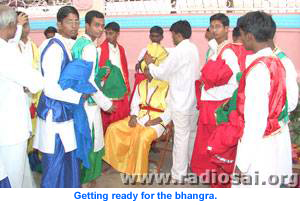 The bhangra dance is noted for its energetic almost martial movements and pounds with abundant energy. The dance steps included a display of rigorous acrobatics and gymnastics that had the audience enthralled. The 'farmers' looked elegant in their rural outfits and I heard that it took 12 minutes to tie the turban (the head-dress) for each 'farmer'.
The bhangra dance is noted for its energetic almost martial movements and pounds with abundant energy. The dance steps included a display of rigorous acrobatics and gymnastics that had the audience enthralled. The 'farmers' looked elegant in their rural outfits and I heard that it took 12 minutes to tie the turban (the head-dress) for each 'farmer'. 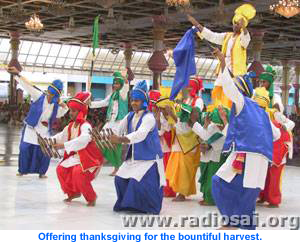
 The first part 'Sathyam Vada' details the story about a thief Mahendra who promises a sage that he will speak the truth under all circumstances. Mahendra on one of his stealing missions makes the acquaintance of the king who occasionally went around his kingdom in disguise to feel the pulse of the people.
The first part 'Sathyam Vada' details the story about a thief Mahendra who promises a sage that he will speak the truth under all circumstances. Mahendra on one of his stealing missions makes the acquaintance of the king who occasionally went around his kingdom in disguise to feel the pulse of the people.  also after the completion of the grama seva activities, the Brindavan students touched everyone's heart through a poignant portrayal of episodes from the life of the blind saint Surdas.
also after the completion of the grama seva activities, the Brindavan students touched everyone's heart through a poignant portrayal of episodes from the life of the blind saint Surdas. 
 It was quite late - only on Oct 2 that Sri S.V. Giri, the former Vice-Chancellor of the Institute, made a public announcement about the grama seva at Swami's behest. Sri Giri further announced that T-shirts and caps were going to be distributed that day to all the students. Though the public announcement was made late, a lot of planning and preparation had already taken place.
It was quite late - only on Oct 2 that Sri S.V. Giri, the former Vice-Chancellor of the Institute, made a public announcement about the grama seva at Swami's behest. Sri Giri further announced that T-shirts and caps were going to be distributed that day to all the students. Though the public announcement was made late, a lot of planning and preparation had already taken place.  Following the public announcement about the Grama Seva, the organization infrastructure was quickly put in place. Committees were formed and group leaders identified. An initial distribution schedule was drawn up and survey parties sent to the villages to evaluate the condition of the roads as well as update the population count of the villages. All the boys were divided into 6 groups with A and B batches, so that the distribution schedule could be alternated between the 2 groups, providing some needed rest in between (however quite a few boys distributed on all the days without any break). To support the Dassera activities going on simultaneously the Vedam and Bhajan boys were identified and exempted from the grama seva. And all this was done within a mere 24 hours.
Following the public announcement about the Grama Seva, the organization infrastructure was quickly put in place. Committees were formed and group leaders identified. An initial distribution schedule was drawn up and survey parties sent to the villages to evaluate the condition of the roads as well as update the population count of the villages. All the boys were divided into 6 groups with A and B batches, so that the distribution schedule could be alternated between the 2 groups, providing some needed rest in between (however quite a few boys distributed on all the days without any break). To support the Dassera activities going on simultaneously the Vedam and Bhajan boys were identified and exempted from the grama seva. And all this was done within a mere 24 hours. 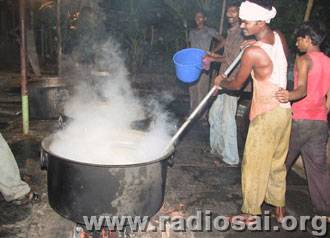
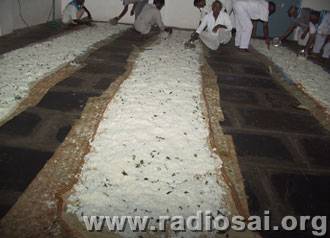
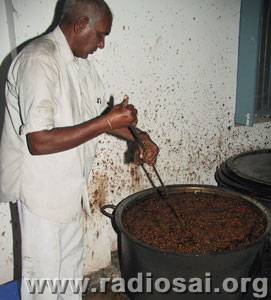


 population and the number of households to be visited by that truck that day.
population and the number of households to be visited by that truck that day. 
 Here is the personal account of the chronicler of Prashanthi Diary who went on all days with the students to give us a first person account of the whole service activity:
Here is the personal account of the chronicler of Prashanthi Diary who went on all days with the students to give us a first person account of the whole service activity: 





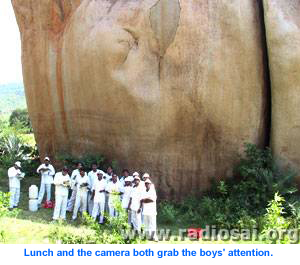













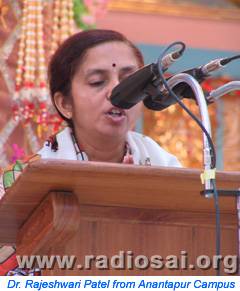
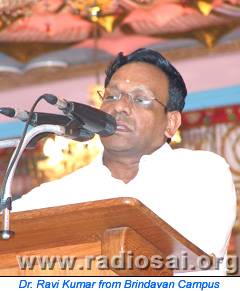

/IMG_7417.jpg)
/IMG_7420.jpg)

/IMG_7691.jpg)
 On October 12 - Vijaya Dasami day, the Surdas drama was staged by the Brindavan students (as reported earlier in the chronicles) to formally bring the Prashanti Vidwan Mahasabha to a close.
On October 12 - Vijaya Dasami day, the Surdas drama was staged by the Brindavan students (as reported earlier in the chronicles) to formally bring the Prashanti Vidwan Mahasabha to a close.